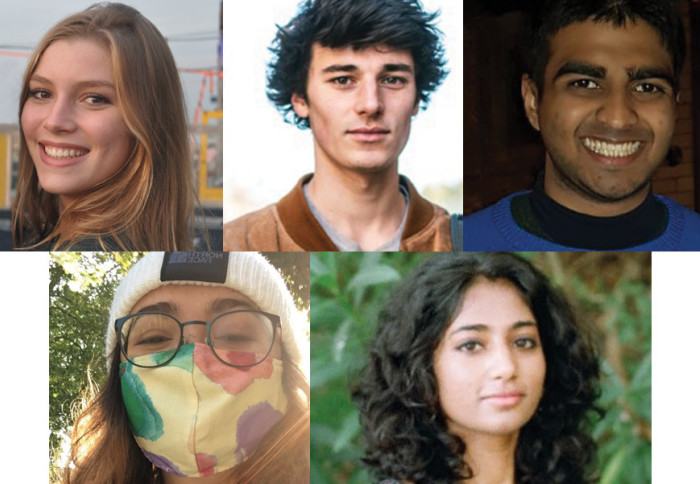

A team of Life Sciences postgraduates won an LSC Digital Hackathon award for their COVID-19 vaccine smart label, capable of monitoring temperature.
The team – pictured above clockwise from top left: Anna Begeer, Arthur Poivet, Abhranil Maiti (Riju), Maisey Davidson and Namrata Gogineni – are all studying the MSc Bioinformatics and Theoretical Systems Biology. Back in January they took part in the London Strategic Consulting (LSC) Digital Hackathon – and won the Innovation Award category – congratulations!
Here they tell us about the competition challenge, how they got creative with ideas and more about their innovative solution.
What is the LSC Digital Hackathon and how did you get involved?
Anna: LSC has annual competitions and projects open to a lot of different universities. Our degree was quite relevant to the subject matter of this competition, and our course is small – there are only 24 of us – so I just asked who wanted to join in, and that’s how the team came together.
We were all quite curious about the challenge, related to vaccine transportation, which is obviously highly topical. Riju Maiti Postgraduate, Department of Life Sciences
Riju: Initially I got involved because I thought it was a good way to get to know my course mates better, and we were all quite curious about the challenge, related to vaccine transportation, which is obviously highly topical. Each COVID-19 vaccine has different storage requirements, and we were being asked to come up with a solution to facilitate that. At the time the Pfizer vaccine had to be stored at a temperature of minus 70 degrees, although some reports say it can be stored at higher temperatures. It felt like a cool, interesting and relevant challenge.
Arthur: It was nice to work on a group project – it was mid-January right after exams, and because of the pandemic we haven’t had much opportunity to meet in person, so it felt like a good way to see other faces and do something together that was science-related, but extra-curricular.
Namrata: Most of the time when I’ve had to apply science and the things I’m learning from my studies it’s always been in a more academic setting, but with this it felt like we had a lot of space to be creative and you got to see how you could use the things you’ve learned in the real-world. It was quite a different and interesting experience to merge the two together.
Was it easy to fit the competition around your studies?
Arthur: We got into an efficient way of working quite quickly. We didn’t have to review what we were doing in the way that we need to for our studies – it was a more free flow of ideas, which I think we all found was an interesting way to work.
Maisey: It was fun as well, because we didn’t really put any pressure on ourselves to win. We all agreed that we were just doing it for fun and to see where we took the interesting ideas.
Anna: Yeah none of us went into this thinking that we wanted to win a prize – we kind of surprised ourselves when we won the Best Innovation category! There were different categories of prize, and that allowed us to be free reign with our ideas because it didn’t have to be the best all-round solution to be worthy of being recognised as being a good solution. A nice thing about this competition was that it focused on quality rather than quantity - it was more about having a good idea rather than the amount of time we spent on it.
Riju: We put a solution together that we all agreed was our best effort, given the time that we could put in, and then we got told that we were in the finals and things moved very quickly. By no means is our solution completely perfect! But it got more refined as the competition developed.
Arthur: We changed ideas about ten times! We tried loads of different options, and encountered problems at every corner. It was fun to work together and it’s really nice to work without pressure, when you don’t really expect anything and you’re doing it literally for the enjoyment of exploring the problem. I think somehow we were more productive because of that.
What have you learnt from the process?
Riju: Ideas can come anywhere, at any time! The part of our solution that I think contributed most to us winning the Innovation Prize was a 1.30am WhatsApp chat. We were all getting ready to go to bed – Maisey was just getting started with her day because she’s in Malaysia – and suddenly it’s like, wow, wait, we have this idea!
Arthur: Every idea that didn’t quite work out still could be adapted and reused. Every step brought something to the table.
Bouncing ideas off each other helped refine them, no matter how crazy the idea was initially, so the process helped me to not be afraid of suggesting crazy ideas! Maisey Davidson Postgraduate, Department of Life Sciences
Anna: Yeah it's a process – while you’re trying to answer one question you end up creating more questions, which you start to answer, and in the end you get to something that ticks most of the boxes of the questions you’ve come up with.
Arthur: It’s interesting working on something that pulls together different sources of knowledge. Exams and coursework are often very specific to one topic that you’re studying at that moment, but this brought together chemistry, bioscience, engineering...
Maisey: Arthur was the only one who'd studied engineering. The rest of us had studied bio-related subjects, and I think it worked well having the combination. Bouncing ideas off each other helped refine them, no matter how crazy the idea was initially, so the process helped me to not be afraid of suggesting crazy ideas!
When you’ve got an idea and you don’t try to express it, it’s kind of frozen. Talking about it keeps it moving, adapting and changing form. Arthur Poivet Postgraduate, Department of Life Sciences
Arthur: Yeah, throwing ideas at each other was really productive. If you’re left with your own idea you might not explore it, or challenge it, that much – it’s not contested in the same way. When you’ve got an idea and you don’t try to express it, it’s kind of frozen. Talking about it keeps it moving, adapting and changing form. It can be hard to know whether your idea is a good one, and expressing it early on to other people helps a lot in judging what’s usable from it – usually not all of it, but some aspects might be reusable. We all got more confident in expressing our ideas.
Riju: The competition element gave us some momentum too – without that kind of focus things can fizzle out easily. The team dynamics – how motivated everyone was – gave me more confidence and drive to push for a strong solution. Anna brought some structure in at the beginning which gave us a clear vision about what we were trying to achieve – it gave us a kind of focus, which really helped.
Anna: The pandemic meant our approach was different – rather than meeting each other at specific times in person, and maybe being sat together for a whole afternoon, it’s been a bit more flexible. Everyone’s been adaptable to having short chats at random times – it’s a slightly different working style I think, and it’s not a bad thing. That freedom allows you to more easily feed off each other and quickly burn or develop ideas – it’s good for creativity.
Arthur: Yeah the process of having lots of quick 20-minute chats about ideas kept things moving and seemed to be a lot more effective than having one long meeting, where conversation might get redundant and you might lose track of what you were talking about at the start. When you schedule meetings in person they generally take longer and you’re less likely to be so efficient.
Tell us more about your idea…
Riju: We had to design tamper-secure digital labels, capable of monitoring temperature, to ensure COVID-19 vaccines were stored safely. Our solution had to be innovative, but also realistic, using currently available resources, that was cost effective and could be scaled up.
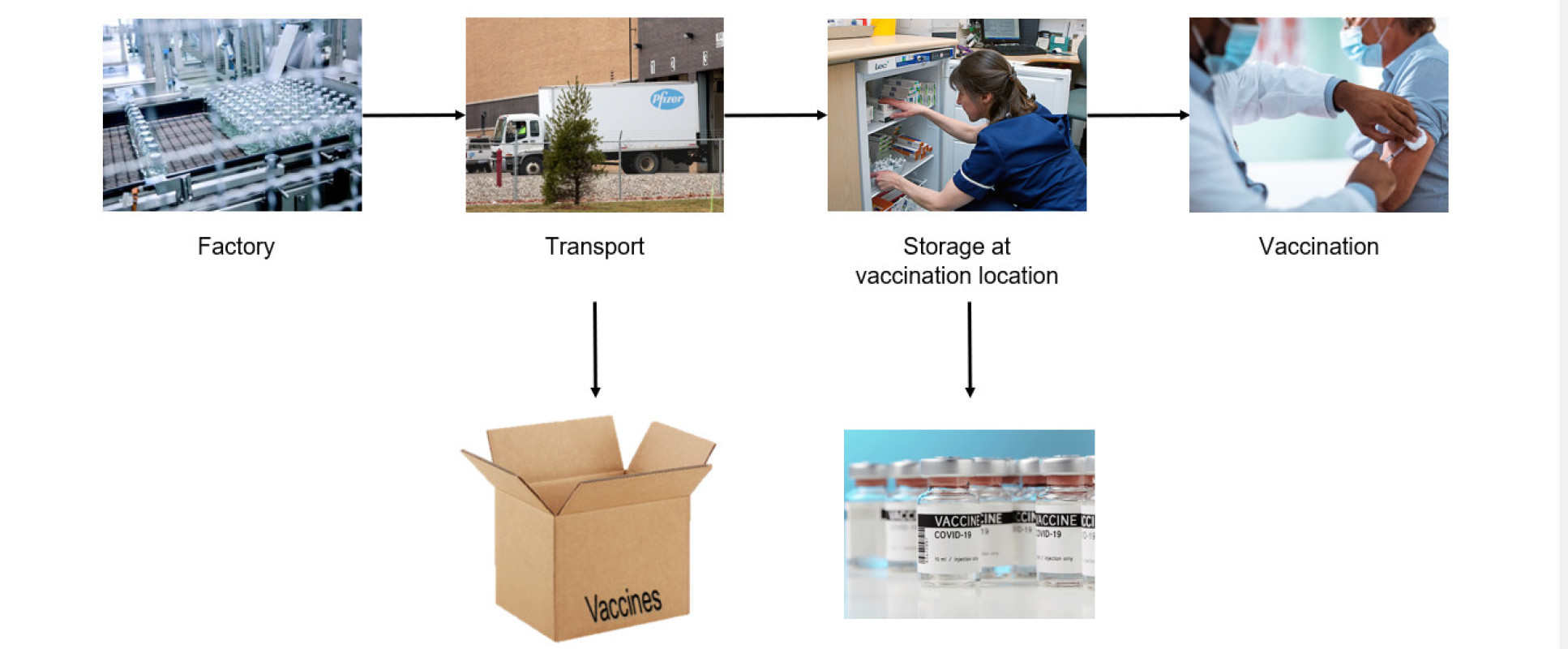
Anna: We divided the supply chain into four stages: factory production, transport in freight vehicles, storage at vaccine locations and the point of vaccine administration. We identified that the vaccines are stored in two different ways – in boxes during transportation, and as individual vials at the vaccination stage.
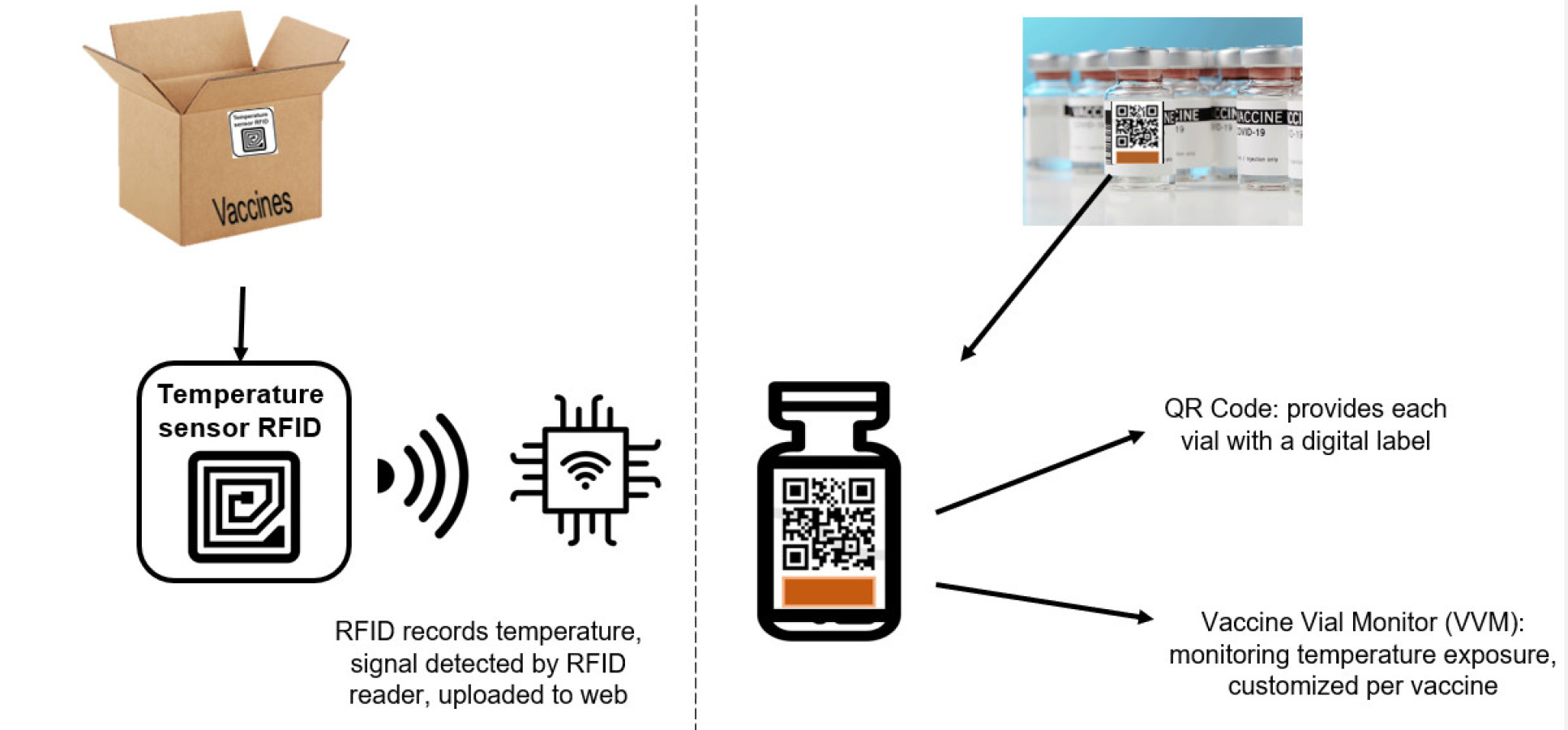
Anna: One part of our solution focused on designing a box label, including a radio-frequency identification (RFID) chip, which records the surrounding temperature. The other aspect is a digital label for each individual vial, which includes a QR code connected to a database with key information about that batch of vials – this is digital and also tamper-safe, so is less susceptible to human-error and can’t be modified by the user.
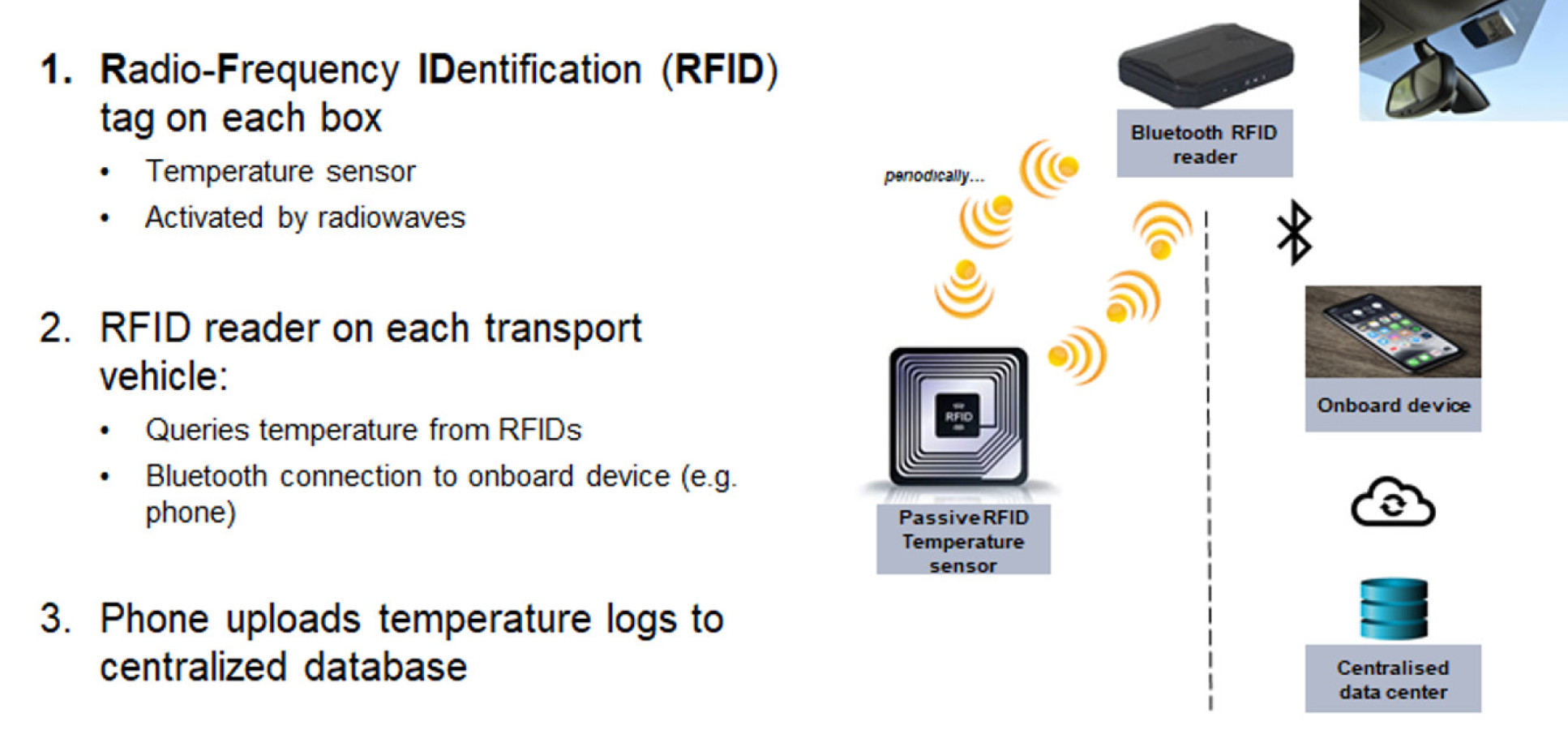
Arthur: The boxes’ RFID tag is essentially a sensor that provides a regular log of data so that you can ensure each individual box isn’t left in an environment with an unsafe temperature for a prolonged period of time. It gets activated via radio waves from a reader that sits on the vehicle, for example on the windscreen. The passive RFIDs take a temperature measurement at regular intervals and send the data back to the reader, which is connected via Bluetooth to an onboard device, for example the driver’s phone or laptop, which in turn uploads it to a centralised data centre. The benefit of using RFIDs is that they’re really cheap, and they function via their own independent energy source, so you don’t need a battery. This was important because the Pfizer vaccines initially needed to be stored at minus 70 degrees, and it would be another challenge to find a battery that efficiently functions at that temperature.
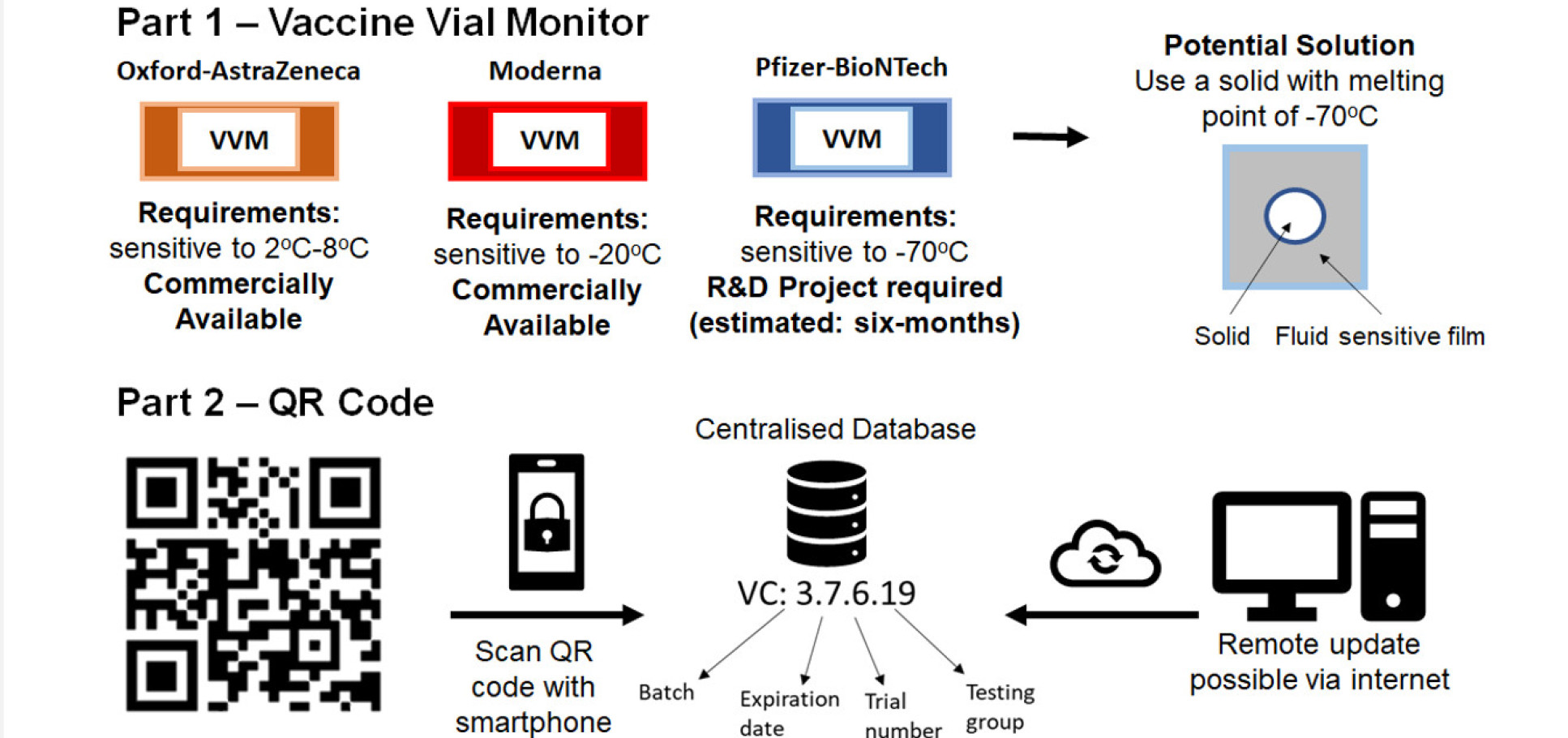
Riju: The individual vial labels are split into two parts. The first part is the vaccine vial monitor – the VVM – colour coded to differentiate between types of vaccine. The VVM is a chemical sticker that changes colour irreversibly if the temperature increases. The Oxford and AstraZeneca vaccines can be stored between two to eight degrees, and outside of that range the sticker changes colour. Same with the Moderna vaccines; they have to be stored at minus twenty degrees and so outside of this range the sticker needs to change colour. For both temperature requirements, VVMs are already commercially available.
For the Pfizer-BioNTech vaccine the VVM would have needed sensitivity at minus seventy degrees, and no such sticker currently exists, but we still wanted to find a way to make this viable. So, we suggested that an R&D project would need to be conducted, and proposed the idea that a piece of solid, with a melting point of about minus seventy degrees, would be immobilised on a fluid sample. If the temperature exceeded minus seventy degrees the solid would begin to melt and react with the film i.e. change colour. Depending how much the film’s colour changes, you can determine how long the vaccines have been exposed to less than minus seventy degrees.
The second part is the QR code, which can be scanned with a smartphone and password protected. This code would access a database via a VC number, including details like the vial’s batch, expiration date, destination and testing group. This information can easily be amended in the back end of the database, and auto reflected across the vials because of the QR code system. If the vaccine’s destination changes at short notice, for example, the stickers on each individual vial don’t need to be amended, you’d just need to update the information on the computer system.
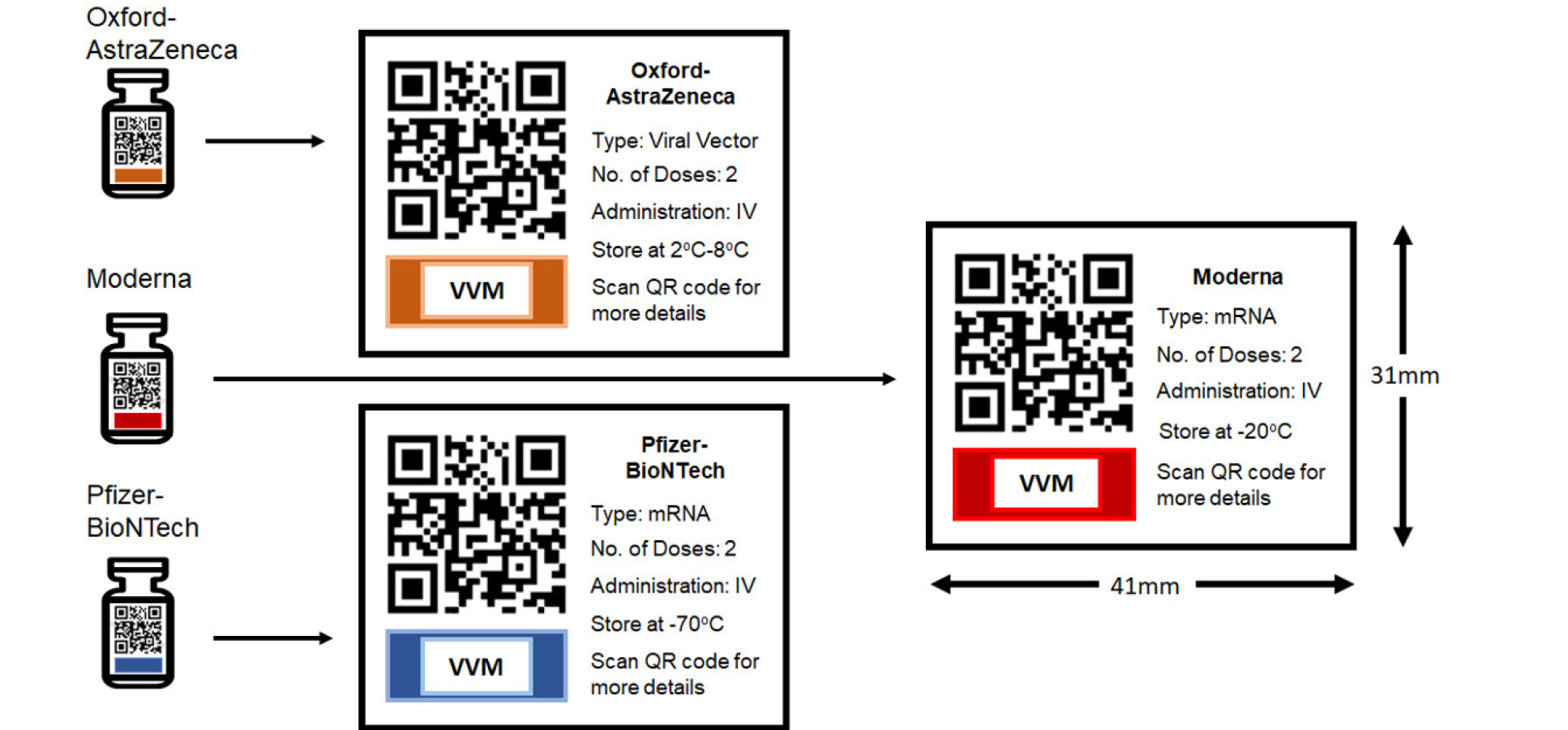
Maisey: The vial label design provides a clear and immediately visual way for nurses to check if that vial had been exposed to high temperatures literally up until the point at which it’s being administered. The QR code is readable by smartphones and difficult to modify, so nurses can check the most up-to-date and accurate information for that batch using the technology that they’ll likely already have to hand. We thought it was important to consider the feasibility of the product design aspect too.
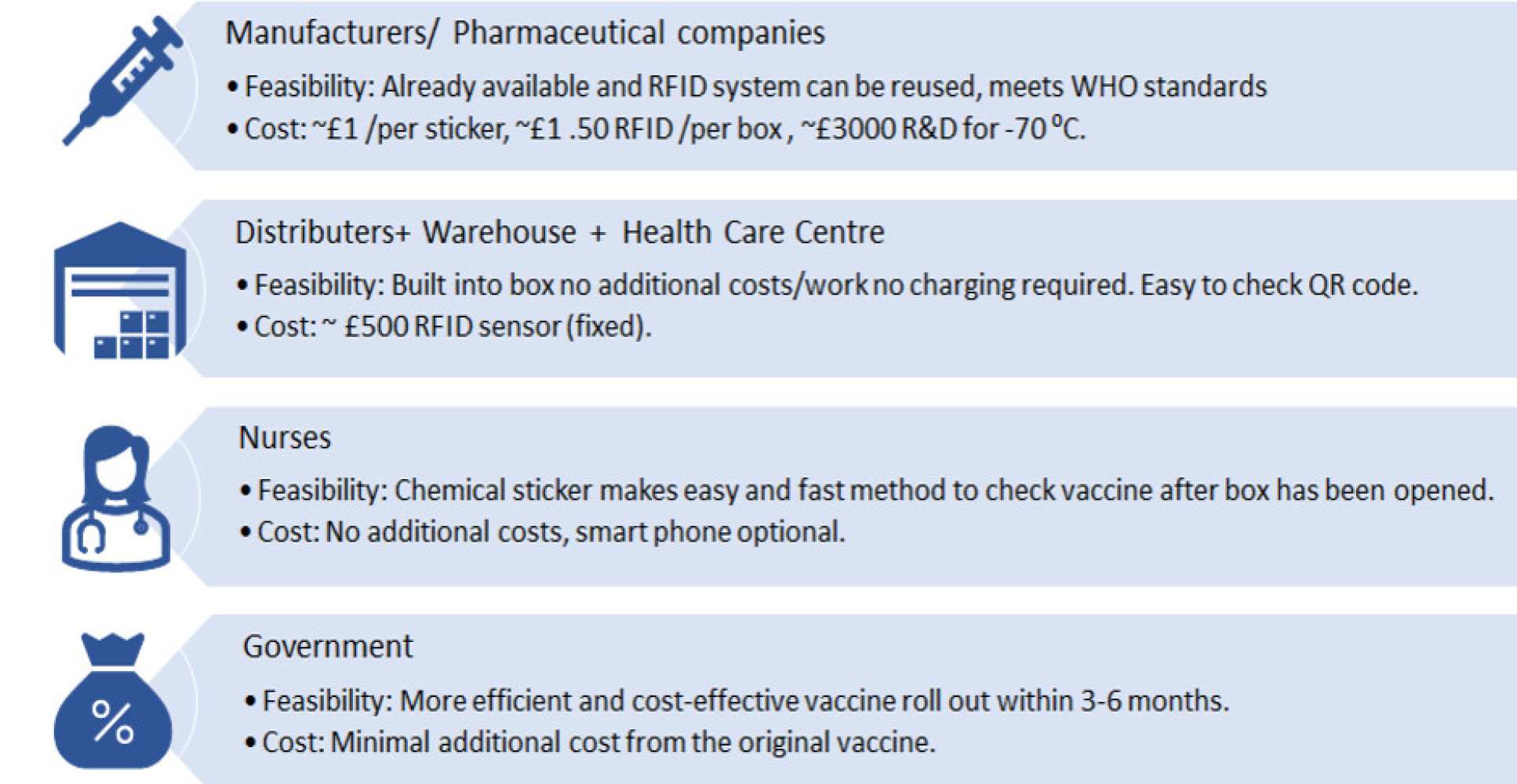
Namrata: We wanted to ensure we kept the whole project as feasible and cost effective as possible, and considered the cost of each component throughout the entire chain.
The faster the vaccine roll out the faster we can come out of lockdown and the sooner we can start to rebuild the economy. Namrata Gogineni Postgraduate, Department of Life Sciences
We managed to keep manufacturing costs pretty low because a lot of the stickers we envisaged using are already in production and relatively cheap. Our distributer and warehouse costs were low because we had a one-time, fixed cost for the box sensors, which can be reused. The individual vial stickers mean that nurses can easily determine whether the vaccine is viable or not, which is cost effective for them as it’s time-efficient, and cuts the cost of wasted vaccine batches. And because a lot of the tools required for our idea are already commercially available, it means that the system could be up and running quickly – we predicted in around three to six months – saving the Government time and money. The faster the vaccine roll out the faster we can come out of lockdown and the sooner we can start to rebuild the economy.
What was it about your idea that you think stood out to the judges?
Riju: One of the business mentors told us that one reason our solution stood out was that it was holistic. We’d considered the different environments that the vaccines would encounter through the whole supply chain, and also the people involved in handling the vaccines at various stages. In particular, we had a focus on the nurses who would be administering the vaccine itself.
Arthur: We’d bounce around completely abstract ideas, that we’d try to design on paper, which maybe gave us the edge on winning the Innovation Award. Part of our solution doesn’t yet exist, but we were able to show how and why it would work – slightly closer to inventing something rather than using purely existing tools.
Has the experience influenced what your career aspirations?
It’s a very real problem that we were addressing, and it’s this kind of applied research that motivates me to be creative. Anna Begeer Postgraduate, Department of Life Sciences
Anna: Our degree is at the interface between quite a few different disciplines – taking the things from biology and computer science that best work together – and that multidisciplinary way of thinking was very useful. Our solution had to be both biologically and commercially feasible within time constraints. The process has reinforced my desire to work on tangible solutions applied to problems in my future career – it’s a very real problem that we were addressing, and it’s this kind of applied research that motivates me to be creative.
Namrata: The project made me keen to look for a career where I can work in an interdisciplinary team. The main thing I took away from the experience is how important it is to have different perspectives when coming up with effective ideas and solutions.
Maisey: Yeah, we approached this challenge from different backgrounds, and that gave a kind of completeness to the team.
Congratulations to the team! Find out more about the Department of Life Sciences and the MSc Bioinformatics and Theoretical Systems Biology.
Article text (excluding photos or graphics) © Imperial College London.
Photos and graphics subject to third party copyright used with permission or © Imperial College London.
Reporter
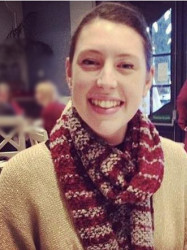
Claudia Cannon
Faculty of Natural Sciences

Contact details
Email: c.cannon@imperial.ac.uk
Show all stories by this author


